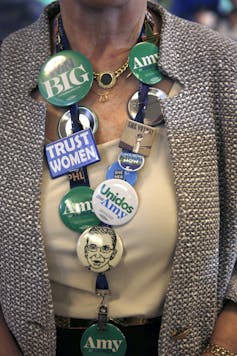
Electability was a significant force motivating voters in the 2022 Democratic primaries.
But what is it? What makes one candidate seem like they could get votes from a majority of voters while another one couldn’t?
Objectively, political scientists like myself have done a lot of research on what types of candidates win and lose. We find that moderate candidates tend to win general elections more often than far-left or far-right candidates do. Despite the widespread assumption that women are less electable than men, research shows that women candidates are at least as likely to succeed as men. That was true in 2018 and 2020, as well as in 2022 primaries for Congress and governor. It’s especially likely when an election year is dominated by scandal, because women are stereotypically viewed as more honest than men.

In legislatures, incumbents probably have a better chance of getting caught at inappropriate texting than they are of losing renomination in their primary or failing to win. And we know that when incumbents do lose, it’s because their challengers surpassed the fundraising threshold that could match the incumbent’s advantages in media coverage, name recognition and other factors, no matter how much the incumbent spent.
Primaries can upend the rules
Of course in general elections, the candidate’s party label is the single major determinant of electability. Most election districts are now dominated by one party, in large part due to gerrymandering. So the dominant party’s candidate is usually assured of winning.
Note the “usually.”
At times, electability in a primary can make a candidate less electable in the general election. Republican Senate primaries offered some interesting examples in 2022. The U.S. Senate is a major battleground in the 2022 midterms because it is currently divided: 50 Democrats, 50 Republicans. Because the vice president casts the deciding vote when there’s a tie in the Senate, Democrats currently control that body because the current vice president is a Democrat. But if Republicans can gain a net of at least one Senate seat in 2022, the Senate will be under Republican control.
Yet in primary elections in several states, Republican primary voters selected the Senate candidate with arguably the weakest chance of winning or holding that seat: think of Mehmet Oz in Pennsylvania, a longtime New Jersey resident who only recently moved to Pennsylvania; Blake Masters in Arizona, who has raised only one-tenth the funding of his opponent; and Herschel Walker in Georgia, an anti-abortion candidate who allegedly paid for his girlfriend’s abortion.
The reason these relatively weak candidates emerged victorious in Republican primaries is that those who turn out to vote in primaries tend to be partisan stalwarts: those with the most deeply held views. In Republican primaries in 2022, pro-Donald Trump partisans were a major force, and voters often chose the Trumpiest candidate, even if he or she had substantial personal, fundraising or electoral vulnerabilities.
Looking at polls, money and mirrors
One way to gauge electability before an election is to look at fundraising data and polls. Early in a campaign, though, poll data often says more about a candidate’s name recognition than his or her public support.
Yet, many people are convinced that regardless of these indicators, the candidate they like better – or dislike the least – will win the election. That was true of many Hillary Clinton supporters in 2016, who simply couldn’t accept that Trump could become president, and of many Trump supporters in 2020, who felt the same about Joe Biden, and continued to feel that way after the votes were counted.
This is bolstered by “confirmation bias,” or the tendency to seek out and remember bits of information that confirm your existing opinions. This tendency is nothing new.
In 1964, supporters of conservative Republican presidential candidate Barry Goldwater believed that their man was destined to win because an invisible – except to them – conservative majority would emerge on Election Day. Goldwater lost in a landslide.

That tendency is even stronger today. Many intense partisans assume that most other citizens agree with their point of view and will step up to the polls given the proper encouragement. The number of partisans who place themselves in news silos – who limit themselves to news sources that share their point of view – has become more possible because of the rise in news sources catering to one partisan or ideological perspective, such as Fox News or MSNBC.
Wishful thinking
The problem with this kind of thinking about electability – that there’s an army of nonvoters who will rush to the polls to support your own values – is the lack of evidence.
A large recent survey showed that nonvoters don’t differ much from voters, other than in their lack of engagement with politics.
“Nonvoters are also far less progressive than is commonly believed,” wrote Yascha Mounk in The Atlantic. “A clear majority of them consider themselves either moderate or conservative; only one in five say that they are liberal.”
Democrats often hope that young people, who lean Democratic, will finally decide to vote in large numbers, unlike previous voters of their generation. But even in the high-turnout midterm elections of 2018, people under 30 voted at much lower rates than people over 65.
Who then, is an electable candidate?
For most primary voters, the most electable candidate is whichever one that voter favors.
This is an updated version of a story originally published on March 9, 2020.
Marjorie Hershey does not work for, consult, own shares in or receive funding from any company or organisation that would benefit from this article, and has disclosed no relevant affiliations beyond their academic appointment.
This article was originally published on The Conversation. Read the original article.







